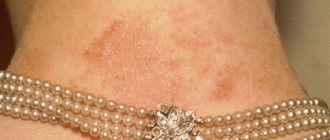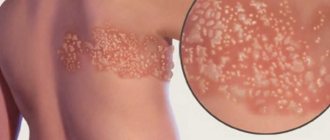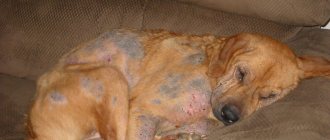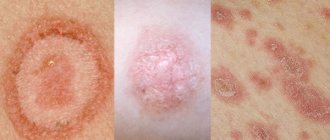Pityriasis versicolor or pityriasis versicolor is a dermatological disease that develops as a result of infection by a fungus.
It has pronounced symptoms, so the disease is easy to recognize at an early stage.
Let's consider whether pityriasis versicolor can appear on the face, the causes of the disease, characteristic signs and treatment methods.
Predisposing factors
Pityriasis versicolor appears due to the influence of negative factors. These include:
- diabetes;
- exhaustion and dehydration of the body;
- bearing a child;
- tuberculosis;
- prolonged stress state;
- postoperative period;
- infection by virus;
- insufficient amount of vitamin A in the body;
- HIV infection;
- increased sweating;
- malignant tumors;
- use of medications from the group of glucocorticosteroids or cytostatics.
Such conditions cause a weakening of the immune system, which plays a decisive role in the appearance of pityriasis versicolor.
Important!
The disease is not dangerous to human health and life, but its occurrence causes severe discomfort from an aesthetic point of view.
What contributes to the development of the disease
There are a number of factors that influence the composition of the sweat-fat layer of the skin. Changes in the chemical composition of sebum provide a favorable environment for fungi. In the fat layer, the concentration of palmitic, oleic, linoleic, linoleic, myristic and stearic fatty acids increases.
Contribute to the development of tinea versicolor:
- the presence of immunosuppressive diseases and conditions. Markers of pityriasis versicolor are diabetes mellitus, tuberculosis, rheumatism and AIDS;
- the presence of diseases that occur with excessive sweating: AIDS, tuberculosis, lymphogranulomatosis, vegetative neurosis;
- living in areas of high humidity;
- professional activity of the patient associated with physical labor;
- increased sweating;
- hereditary predisposition.
Rice. 8. A common form of pityriasis versicolor.
Rice. 9. A common form of pityriasis versicolor.
Types of disease
In medicine, the following types of pityriasis versicolor are distinguished:
- Inverted. It is the formation of spots in the folds of the skin, has a sluggish nature, without signs of an inflammatory process.
- Erythematous-squamous. It is characterized by the appearance of spots of different sizes and is not accompanied by inflammation.
- Follicular. The most severe type of lichen, spots and ulcers appear on the face. They cause itching and burning and occur with inflammation.
Important!
Pityriasis versicolor is one of the few types of lichen that is infectious in nature.
The role of Malassezia furfur in the development of seborrheic dermatitis
Malassezia furfur has been proven to play an etiological role in the development of seborrheic dermatitis. Normally, fungi of this type make up 46% of the microflora of the scalp, with dandruff - 74%, with seborrheic dermatitis - 83%.
Seborrheic dermatitis is an early manifestation of HIV infection. This disease is registered in them in 30-80% of cases, while seborrheic dermatitis in healthy people is registered in 30-5% of cases. In AIDS, seborrheic dermatitis resembles psoriasis and is resistant to therapy.
Rice. 10. Pityriasis versicolor on the skin of the neck.
Signs and symptoms
Lichen versicolor is characterized by the appearance of brownish, whitish, reddish spots on the skin, which in appearance resemble pigmentation .
Round-shaped spots increase in size over time (without proper treatment), gradually merging into a single affected area.
The surface of the spots is covered with small scales, visually it seems that the skin is slightly sprinkled with flour. Often such formations are painless .
The color of the spot depends on the skin tone and tan.
Diagnostic methods
Diagnosis of lichen versicolor is not difficult for a doctor. He performs the Balser test.
The procedure involves applying an iodine solution to the stain; under the influence of a special lamp, it begins to turn bluish.
Before prescribing therapy, the patient undergoes a series of studies to determine the cause of the disease:
- general blood analysis;
- blood sugar level;
- biochemical blood test to identify/exclude chronic pathologies:
- blood test to determine HIV infection.
The best drugs for treating disease in humans
Equally effective drugs from trusted manufacturers are considered a good alternative to antifungal ointments in the treatment of tinea versicolor.
Terbinafine
An antifungal agent, the active components of which provoke the destruction of cell membranes of harmful microorganisms and cause their death. The medicine is applied to the affected areas twice a day for 14 days.
The spray is not recommended for use in the presence of tumor neoplasms, individual intolerance to individual components and impaired vascular condition.
Lamisil
A medicinal solution against pityriasis versicolor containing terbinafine. The active substance instantly suppresses the development of fungal infection, eliminates the manifestations of the pathological process and prevents the reappearance of the fungus.
During therapy, the patient may develop adverse reactions in the form of itching, peeling or burning at the site of application.
Important!
Unlike other drugs, the duration of the therapeutic course using Lamisil spray is only 7 days.
Thermikon
The drug has fungistatic and fungicidal effects. Once on the skin, the components of the product penetrate deep into the membrane of the fungi and destroy them. The solution has a small list of contraindications and side effects, which is one of its advantages over other means.
Fungoterbin
Spray with a wide spectrum of antifungal action. The solution is applied to the lesions 1-2 times a day for two weeks.
Fungoterbine is prohibited for use by children under 12 years of age . Patients with suppression of bone marrow hematopoiesis, tumors, renal or liver failure should use the drug with caution.
How to treat the disease?
There are a number of ways to combat the disease. You can be treated with both medications and alternative medicine.
Drug therapy
In some cases, pityriasis versicolor in humans disappears on its own. But proper treatment will help speed up the healing process . The basis of drug therapy is the following drugs:
- Antifungal ointments - Dermazol, Kanizon, Ecodax, Mycozon, Exoderil. Such drugs have a detrimental effect on the pathogen.
- Ointments to eliminate symptoms - Salicylic ointment, Glycolic acid, resorcinol alcohol. The products help soften the skin - the affected cells begin to separate, and a healthy epidermis is restored.
- Antifungal tablets - Oronazole, Nizoral, Flucostat. They are used in cases where local therapy does not provide positive dynamics for recovery.
- Shampoos - Keto Plus, Nizoral. Used when lichen spreads to the scalp.
Important!
Medicines for pityriasis versicolor are used only after the prescription of a dermatologist, who also determines the dosage.
Traditional treatment
In addition to medications, you can treat with folk remedies. The most effective recipes:
- Snapdragon. You will need 2 tablespoons of snapdragon flowers and a little butter. Chop the plant, add softened butter, mix thoroughly. Apply the prepared ointment to the affected areas of the skin on the face.
- Blueberry. Boil the blueberries and grind them to a paste consistency. Apply it to the lichen.
- Raisins and prunes. You need to take the ingredients in equal proportions and grind them through a meat grinder. Wipe your face with the prepared mixture.
- Onion. It is necessary to chop the onion well and squeeze out the juice through cheesecloth. Treat emerging stains with liquid several times a day.
- St. John's wort. Pour 2 tablespoons of dried St. John's wort into 1 cup of boiling water and leave for 1 hour. Wipe the affected areas of the skin with the prepared infusion.
Important!
Folk remedies are used only as an additional method of treatment. They cannot eliminate fungal activity on their own.
Diet
To quickly get rid of multicolored lichen, you should adhere to proper nutrition. The daily diet should be filled with the following products:
- dairy and fermented milk products;
- green vegetable salads;
- greenery;
- healing mineral water;
- iron-fortified foods;
- buckwheat, rice, oatmeal;
- honey.
Foods that are not recommended for illness include:
- smoked products;
- spices;
- pickled and salty dishes;
- meat and fish of fatty varieties, this also includes strong broths based on them;
- fast food;
- canned food;
- spicy dishes;
- legumes;
- sweets;
- alcohol.
In addition, it is necessary to minimize the consumption of strong tea and coffee.
Causes of pityriasis versicolor
The causative agents of pityriasis versicolor are the fungi Pityrosporum orbiculare and Malassezia furfur. There are versions that the development of the disease is largely determined by the chemical composition of sweat, individual predisposition of the skin, pathologies of the stratum corneum of the epidermis, especially physiological peeling. Excessive sweating can also contribute to the onset of the disease. Also, some doctors suggest that people with pulmonary tuberculosis are more likely to develop lichen versicolor.
Most often, lichen versicolor affects young people, both men and women equally, but it also affects children with weak immunity, suffering from diabetes, and vegetative neurosis. A separate risk group consists of adolescents who experience increased sweating during puberty.
Solar radiation, ionizing radiation, heavy metals, wearing clothes made of synthetic fabrics, diabetes mellitus and other diseases of the endocrine system also increase the likelihood of developing lichen versicolor.
Most people believe that tinea versicolor occurs due to internal problems in the functioning of the body. Modern dermatologists insist that this disease can be transmitted from one person to another. Therefore, pityriasis versicolor is classified as a conditionally pathogenic disease. After infection with a fungus, not every person begins to develop dermatological disorders.
It has been established that most of humanity is a carrier of a fungus that can cause pityriasis versicolor, but the progression of the disease is typical for people with impaired immune function.
In this regard, infection can occur in the following situations:
- With frequent close contacts, which are typical for family relationships;
- When using personal hygiene items or things that the patient used (washcloth, outerwear, towel, etc.);
- When visiting public locker rooms, fitting rooms.
The fungus can remain dormant on the skin for a long time. Its incubation period lasts from two weeks to several months. During this time, the person does not even suspect that he is a carrier of an opportunistic microorganism. The transition to the active phase of reproduction with characteristic clinical manifestations will occur when conditions are suitable for this.
Therefore, the causes of pityriasis versicolor in humans may be as follows:
- The presence of a predisposition of a particular person’s skin to the development of dermatomycosis.
- Increased work of the sebaceous glands, disruptions in the natural physiological processes occurring in the upper stratum corneum of the epidermis.
- Hyperhidrosis, leading to disturbances in the chemical composition of sweat. This creates favorable conditions for the proliferation of mycotic microorganisms.
- Chronic diseases, for example, diabetes, endocrine pathologies. Obesity and vegetative neurosis have a negative effect on the condition of the skin.
- Infections that affect the reduction of the body's immune forces. Of particular danger in this regard are caries, chronic tonsillitis, and pyelonephritis.
- Patients with tuberculosis are more susceptible to dermatomycosis than other people, and, in particular, pityriasis versicolor. Therefore, when detecting this pathology, the doctor must make sure that the patient does not only have a pulmonary form of tuberculosis, but also exclude tuberculosis of the kidneys, bones, etc. It is known that these infections often have a latent course and can be expressed in dermatomycosis.
- Diseases of the digestive organs, pancreas and liver have a negative impact on the condition of the skin and hair.
- Vegetative-vascular dystonia can also cause the development of pityriasis versicolor. In this case, the patient may note such health problems as dizziness, frequent depression, panic attacks.
- Diseases of the pulmonary system. Pneumonia, bronchitis, and bronchial asthma have a negative effect on the skin condition.
- Before the age of 7 years, pityriasis versicolor is almost never diagnosed. Isolated cases of the development of this dermatomycosis in children can be explained either by a sharp decrease in immune forces, or by the presence of a serious illness in the child.
- Women suffering from pityriasis versicolor should be checked for pathologies of the ovaries and adrenal glands. It is possible to develop dermatomycosis during pregnancy and during menopause.
- Frequent use of shower gels that have an antibacterial effect has a negative effect on the condition of the skin. The same applies to soap and other products used for personal hygiene.
- Stressful effects on the skin should be avoided, for example, visiting a solarium, excessive tanning, and exposure to solar radiation.
There is a theory that pityriasis versicolor may be a genetic disease. However, most scientists are of the opinion that close relatives are prone to disturbances in the functioning of the immune system. This, in turn, leads to the development of various fungal skin infections.
Recommendations from experts
During the treatment of pityriasis versicolor, dermatologists recommend adhering to the following rules:
- wash bed linen and towels in boiling water;
- after washing, iron them on both sides;
- carry out wet cleaning daily;
- Wash all hygiene items thoroughly with boiling water and soap.
Important!
Despite the fact that there are known cases of curing lichen after sunbathing, you should not intentionally sunbathe. Ultraviolet rays have a negative effect on the course of this disease.
Ringworm in children and pregnancy
In children, lichen of this type is diagnosed quite rarely. It occurs as a result of a weakened immune system, constant stress and increased sweating.
Experts note the frequent occurrence of the disease in children due to the use of various antibacterial bathing agents. In most cases, children over 10 years old are susceptible to pityriasis dermatitis.
The disease in children has similar symptoms as in adults. The incubation period is approximately three weeks.
Women during pregnancy are also susceptible to pityriasis dermatitis. At this time, immunity decreases, hormonal levels change, which provokes the activity of fungi.
This type of lichen does not have an adverse effect on the expectant mother and baby, but pityriasis versicolor dermatosis needs to be treated. Specialists will select the safest drugs for internal and external use.
Possible complications of the disease
Complications with lichen versicolor can occur if the disease is ignored. A person begins to be very bothered by the following symptoms:
- significant lesions;
- unbearable itching;
- excessive peeling of the skin on the face.
Important!
Pityriasis versicolor is a contagious disease. It can be transmitted through hygiene items and clothing.
Prevention and reviews
To avoid the onset of illness, it is necessary to monitor the state of the immune system, treat all diseases in a timely manner, and try to avoid nervous stress and shock. Frequent exposure to fresh air, moderate physical activity, proper nutrition, and control of medication intake have a beneficial effect on the body's condition.
Pityriasis versicolor is an unpleasant disease that causes a certain amount of discomfort to a person. It can last for quite a long time, appearing periodically. Therapy is selected based on the patient’s condition and the advanced stage of the disease.











